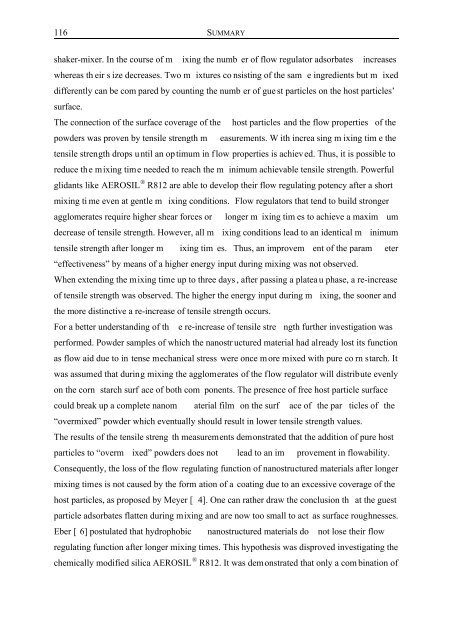Untersuchungen zur - OPUS - Universität Würzburg
Untersuchungen zur - OPUS - Universität Würzburg
Untersuchungen zur - OPUS - Universität Würzburg
Sie wollen auch ein ePaper? Erhöhen Sie die Reichweite Ihrer Titel.
YUMPU macht aus Druck-PDFs automatisch weboptimierte ePaper, die Google liebt.
116<br />
SUMMARY<br />
shaker-mixer. In the course of m ixing the numb er of flow regulator adsorbates increases<br />
whereas th eir s ize decreases. Two m ixtures co nsisting of the sam e ingredients but m ixed<br />
differently can be com pared by counting the numb er of gue st particles on the host particles’<br />
surface.<br />
The connection of the surface coverage of the host particles and the flow properties of the<br />
powders was proven by tensile strength m easurements. W ith increa sing m ixing tim e the<br />
tensile strength drops until an optimum in f low properties is achieved. Thus, it is possible to<br />
reduce the mixing time needed to reach the m inimum achievable tensile strength. Powerful<br />
glidants like AEROSIL ® R812 are able to develop their flow regulating potency after a short<br />
mixing ti me even at gentle m ixing conditions. Flow regulators that tend to build stronger<br />
agglomerates require higher shear forces or longer m ixing tim es to achieve a maxim um<br />
decrease of tensile strength. However, all m ixing conditions lead to an identical m inimum<br />
tensile strength after longer m ixing tim es. Thus, an improvem ent of the param eter<br />
“effectiveness” by means of a higher energy input during mixing was not observed.<br />
When extending the mixing time up to three days , after passing a platea u phase, a re-increase<br />
of tensile strength was observed. The higher the energy input during m<br />
the more distinctive a re-increase of tensile strength occurs.<br />
ixing, the sooner and<br />
For a better understanding of th e re-increase of tensile stre ngth further investigation was<br />
performed. Powder samples of which the nanostr uctured material had already lost its function<br />
as flow aid due to in tense mechanical stress were once m ore mixed with pure co rn starch. It<br />
was assumed that during mixing the agglomerates of the flow regulator will distribute evenly<br />
on the corn starch surf ace of both com ponents. The presence of free host particle surface<br />
could break up a complete nanom aterial film on the surf ace of the par ticles of the<br />
“overmixed” powder which eventually should result in lower tensile strength values.<br />
The results of the tensile streng th measurements demonstrated that the addition of pure host<br />
particles to “overm ixed” powders does not lead to an im provement in flowability.<br />
Consequently, the loss of the flow regulating function of nanostructured materials after longer<br />
mixing times is not caused by the form ation of a coating due to an excessive coverage of the<br />
host particles, as proposed by Meyer [ 4]. One can rather draw the conclusion th at the guest<br />
particle adsorbates flatten during mixing and are now too small to act as surface roughnesses.<br />
Eber [ 6] postulated that hydrophobic nanostructured materials do not lose their flow<br />
regulating function after longer mixing times. This hypothesis was disproved investigating the<br />
chemically modified silica AEROSIL ® R812. It was demonstrated that only a com bination of

















